|
Bristle/Fireworms Identification
FAQs 6
Related FAQs: Polychaete ID 1, Polychaete ID 2, Polychaete ID 3, Polychaete ID 4, Bristleworm ID 5, Bristleworm ID 7, Bristleworm ID 8,
Bristleworm ID 9,
Bristleworm ID 10,
Bristleworm ID 11,
FAQs: Worm Diversity
FAQs, FAQs
2, FAQs 3, & Worm IDs
1, Worm IDs
2, Worm IDs 3, Worm IDs 4, Worm
IDs 5, Worm IDs 6, Worm IDs 7, Worm
IDs 8, & Worm ID FAQs by Group/Phylum: Flatworm Identification ID, Nemertean, Proboscis, Ribbon Worm ID,
Nematode, Roundworm ID,
Nematomorpha,
Horsehair Worm ID, Acanthocephalans,
Thorny-headed Worm ID, Tubeworm ID, Hirudineans, Leech ID, Sipunculids, Peanut Worm ID, Echiuran Worm ID, & Bristle/Fireworms 1, Bristle/Fireworms 2, Bristle/Fireworms 3, Bristle/Fireworms 4, Worm
Identification, Polychaete Behavior, Polychaete Compatibility, Polychaete System, Polychaete Selection, Polychaete Feeding, Polychaete Disease, Polychaete
Reproduction,
Related Articles: Worms,
Polychaetes, Flatworms/Planaria,
|
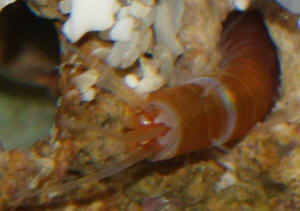
|
ID Please... Hair Worm (Cirratulid species)
3/14/08 Hey there all, <Hi Tim, Mich here!> I was
wondering if you might be able to ID this for me. I spotted it on
some of my Live Rock. <Looks like a hair worm (Cirratulid
species) to me, a harmless filter feeder. Often crabs, including
hermit, cleaner shrimp and nipping fish prey upon these beneficial
worms.> Thanks Much, Tim
<Welcome much, Mich> |
|
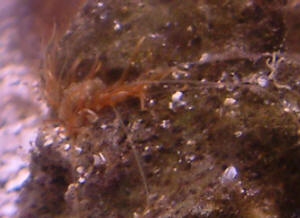
|
|
Hitchhiker ID: Likely Amphinomid - 3/10/08
Hello, <Hi there, Sheye!> First I would like to thank you
all for doing an incredible job on the site. Your site has
provided me with answers to several of my question and given me
hours of reading enjoyment. <Excellent!> Now my question. I
recently purchased a total of 30lbs of Fiji live rock from my
LFS. I was amazed to find so many hitchhikers (spiny brittle
stars, common and blue-legged hermits, and several sponges).
<Neat> But one of them I was unable to identify (pic
attached). It looks like some sort of worm or Nudibranch but may
also be a larvae of some sort. I doubt it is harmful <Likely
not, especially at this size.> as most hitchhikers aren't
and this one seems to munch on the algae. I would just like to
know what it is. <Hmmm, I'd need to see more detail to be
sure, but it looks like an Amphinomid/bristleworm, possibly in
the genus Chloeia. Please see the photos at these links for
comparison: http://www.wetwebmedia.com/polychaetes.htm
http://calphotos.berkeley.edu/cgi/img_query?query_src=photos_browseimgs_invertebrate_sci&seq_num=226453&one=T>
Thanks for your time Sheye <You're most welcome! Take
care, -Lynn>
Re: Hitchhiker ID: Likely Amphinomid -
3/11/08 Hello again, <Hi Sheye> After looking at the
links you provided. I have found it. In this link
(www.wetwebmedia.com/polychaetes.htm) under Hermodice canunculata
the last picture on the right. That is exactly what it looks
like. <Yay! Mystery solved!> Thanks again!!! Sheye
<You're very welcome! Take care, -Lynn>
|
|
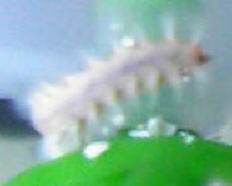
|
|
Critter ID: Eunice spp. Worm -- 2/15/08 Hi
crew - and thanks again for the great resource! <Always a
pleasure to share information with fellow hobbyists!> I'm
attaching two photos of a critter I found in my live rock.
<Yes, I see it. What you have is a polychaete worm in the
genus Eunice, aka a "Bobbit worm" (after Lorena Bobbit
- not going there!). Nice photos by the way, considering how
quickly these worms can move!> The hole it's in is about
3cm wide, <3cm or 3mm?> and the critter pretty much fills
the hole. <Thankfully, it looks like it's the length of
the worm that's filling it up (at this point), not the width!
I'm basing that on what appears to be a nearby Collonista
spp. snail. Those supposedly top out at around 1/4" although
most I've seen are around 3mm.> The front end looks like
some kind of orange worm with antennae - the longest single
antenna comes out of the middle of its head, <Characteristic
in these worms.> ..then there are two sets on either side,
with the lower set being shortest. <Yep. Terrific
observations, by the way!> The lower part of the face appears
to have flaps that remind me of walrus cheeks!
<Coo-coo-ca-choo! Behind those 'cheeks' are some
wickedly impressive jaws.> The back end appears to be
shrimp-like. <I see what you mean. It does look a bit like the
tail end of a mantis shrimp, but this little guy is all
polychaete annelid worm.> I haven't determined how long it
is, as I've never seen it completely out of the hole, but it
did stretch its head out of the hole one time about 9-10cm and I
didn't see the tail at all then, <Heeheee! Just wait until
you find out what length some of these worms can reach! As if
it's not a bad enough sign already that they're named
after a woman who...well, never mind. To give you an idea, Bob
has one in a jar that's eight feet long. Another fellow in
Oregon has photos of a seven footer that was in his tank. The
good news is that this is not the norm. I've had several of
these in my tanks over the years and none have gotten very large
or caused any problems. However, if I ever find a seven foot
Eunice worm in my tank, the resultant scream is going to rival
the infamous 1883 eruption of Krakatoa/Krakatau, aka the
'loudest sound ever heard by man'!> ..and didn't
see any additional white bands either. <That's typical of
the hitchhiking Eunicids I've seen as well. They usually have
one light/whitish collar (or band), on/near the 'head'
and that's it.> I seriously thought it was a worm until
the photo showed the shrimp-like tail (it moves so fast I could
never see it without the still shot). <Indeed. I read
somewhere that these worms have been clocked retracting into
their holes at speeds in excess of 20 feet per second. Now
that's fast.> I haven't seen any pinchers or claws,
<The jaws are tucked away until needed.> and I haven't
heard any clicking noises either. <Nope, there wouldn't be
any coming from these polychaetes.> It is very shy and spooks
easily - darts very quickly back inside the hole, <Oh yes!>
but also seems curious (or hungry) enough to peek out quite
often. <This behavior should come in handy if/when you need to
trap it.> I have searched every descriptive word for it that I
can think of <LOL Let's see..worm with shrimp tail, shrimp
with worm head...Shwormp! Sorry, couldn't resist ;-)>
..& looked through tons of shrimp and worm photos on various
sites, but can't find anything quite like it. <Although
I've made these worms sound like something out of a horror
movie, they're not all bad. Some are scavengers that do a
good job of keeping a tank clean. This is especially true of
those species that stay small. Others, however, are decidedly
predatory. They eat sessile organisms, small crustaceans, and are
quite capable of catching/killing fish. Those jaws, combined with
impressive speed, make for a very efficient ambush predator.
Personally, I wouldn't trust any large Eunice worm in my
tank. For that matter, I wouldn't trust even a smaller one in
a tank with tiny gobies in it. Keeping the worm well fed would
likely help to deter predation, but it would be a gamble. I have
a Eunice worm in one of my tanks right now that looks very
similar to yours. It's been in residence for about a year and
a half. The diameter is about 2.5mm and the length is around 7cm.
I've tried to bait/trap it, but have never succeeded.
Thankfully, it hasn't caused any problems and I'm hoping
it stays that way. As long as he behaves himself he can stay. The
minute he approaches 1/4" in diameter, though, he's out
of there! If I have somehow misjudged the size of the worm in
your tank, and it is indeed 3cm (or close) in diameter, I'd
recommend trapping and removing. There are many traps available
on the market, as well as homemade versions covered at WWM and on
the internet. If the worm is fairly small, you can either keep an
eye on it and trap later if necessary, or try to get it out of
there now. It just depends on what type of livestock you want to
keep, or already have, in your tank. Heeheee, that and whether
you're feeling lucky! For more information on Eunice spp.
worms, please use WWM's search engine:
http://www.wetwebmedia.com/WWMAdminSubWebIndex/question_page.htm
See the following WWM link as well, about halfway down, for a
photo of a similar worm:
http://www.wetwebmedia.com/polychaeidfaqs.htm
http://www.reefkeeping.com/issues/2003-04/rs/index.php >
Thanks for your time. <You're very welcome!> You
provide a wonderful service with a great sense of humor.
<'Laughter is the shortest distance between two
people'. Truly, it's a measure of how much we enjoy what
we do here, and life in general. Take care, -Lynn>
Re: Critter ID: Eunice spp. Worm -- 2/15/08
<Hi Lillian!> Okay, so I'm from the US & screwed up
the measurement <Heheeee! I thought something wasn't
adding up! Not to worry - I've done it a time or two
myself!> - the hole opening is about 3mm, not 3cm. And I
forgot to sign the previous email. Sorry. Lillian B. :) <No
worries, Lillian. Thanks for confirming those measurement for me.
Take care. --Lynn>
|
|
 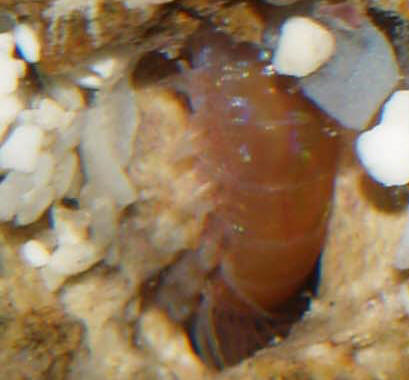
Nice pix! RMF.
|
Worm ID: Spionid/Chaetopterid? -
12/25/07 Hi there. <Hi Jamie.> I have a strange worm in my
tank that I am struggling to identify. The worm is around 50mm
<5cm/~2'> in length and is white and brown on the body.
<Are you actually seeing the body of the worm, or a tube? Where is
it situated/living -- in the substrate, on a rock, in a rock,
elsewhere? This is where a photo could really come in handy.> It has
two tentacles (which are translucent and about 300mm long) <Yikes,
300mm/30cm/almost a foot in length? Are the tentacles
mobile/active?> and comes out during the day (which makes me think
it isn't a spaghetti worm). Through some searching the closest I
can find is a Mud Whip Worm. <Polydora spp. -- shell borers in the
family Spionidae.> However I can find very little information on mud
whip worms and so can't be sure that this is exactly what I have.
Do you have any clues as to what the worm might be? <Sounds very
much like something in the family Spionidae, or Chaetopteridae. The two
hair-like translucent tentacles/'palps', are characteristic of
worms in these two families. These detritivores/particulate feeders
live in hardened mucus tubes, or 'U' shaped burrows. Some tubes
look very much like parchment, others have bits of substrate, shell,
sand grains, or even silt cemented to the outside. This is most likely
what's in your tank, but without a photo/more info..? Please see
these links, as well as Google Spionidae and Chaetopteridae, for more
information/confirmation: Spionidae:
http://www.reefs.org/library/aquarium_net/1197/1197_1.html
Chaetopteridae:
http://www.reefs.org/library/aquarium_net/0897/0897_5.html> Thanks
very much! Jamie <You're very welcome! -Lynn>
Re: Worm ID: Spionid/Chaetopterid? -
12/25/07 <Hi Jamie!> Thank you very much! <You're very
welcome!> I am wrong with 300 mm, should be 30mm!!! Big difference,
I know. <Heeee! I had a feeling it was probably 30mm/3cm!> But
the links you have sent me are great! I love seeing new and interesting
creatures in my tank, and so am pleased you have pointed me in the
right direction. <My pleasure. It really is great fun, isn't it?
I think of live rock as the gift that keeps on giving!> Thanks
again! Jamie <You're most welcome! Take care
--Lynn>
Worms and Nocturnal Critters... Cirratulids,
Eurythoes, and Gammaridean Shrimp Oh My! 11/30/07
Hello Crew, <Hi Sammy, Mich here.> Your site has been a
tremendous help for me. I like to add to the many praises your guys
are getting. <Thank you for your kind words.> I have a 175
gal reef tank that has been running for 6 months. I am now finding
a lot of worms and nocturnal critters that seems to be quickly
growing in numbers. I just like to know if this is something I need
to get concerned about. <Generally, no. Usually this is all
good.> First, the number of string worms has increased greatly.
There is a bunch every inch or so on the sand. Some have moved onto
the rocks as well. Here is a photo of it. These guys send out long
tentacles to pull larger sand pebbled towards the group to form a
little mount on the sand. The fish don't bother it at all.
<This is a hairworm, a Cirratulid species. They are beneficial
scavengers and a wonderful addition to your tank.> Next to it is
a worm that comes out only after the lights are off. These are also
increasing in number. Both of these are really creeping my wife
out. <Well they are creepy-crawlies, so I do understand your
wife's reaction, but beneficial and commonly found in systems
with live rock.> Here is a closer shot of the nocturnal worm.
Some are 4 inches long. I find them at the base of every rock in my
tank. <This is a fireworm (Eurythoe sp.) and named so with good
reason. You're not going to want to touch these guys. The
chaetae/bristles contain venom and can pack a rather painful sting.
That being said, these touch-me-nots are beneficial scavengers and
another fine additions to your system.> It is hard to get a good
photo of these guys. As soon as I shine a flashlight on them to
focus my camera, they scurry away into hiding. <Yes, but your
photos are decent.> A third critter that only shows up at night
is something that looks like a shrimp, but it crawls all over the
rocks like wobbly bugs. Here is a photo. <This is a Gammaridean
amphipod, commonly called a Scud, or your fish might call them
yummy! Again their presences in your setup is an asset.> I
really appreciate your help in identifying them. Should I get rid
of them? <Nope! Keep'em!> And if so, how? I have one more
question. I have this black pearl that is growing on one of my
coral. What is it? <It is Valonia, a nuisance alga. Try to
gently remove it, wiggle it carefully with your fingers and
hopefully it will come lose. Try not to break the bubble which
contains reproductive material that you do not want to spread
around your tank!> Is it normal to have it on this kind of
coral? <Is not uncommon but you don't really want it
there!> That feather duster seems to be an invader of this coral
also, right? <Yes.> Should I leave it alone? <Yes.>
Regards,
<Cheers, Mich>
Sammy |

 |
/Amphipods/image004.jpg)  |
| Worm ID and Reproduction 11/11/07
Hey Crew, <Scott> I have a 520L (130g) Reef tank with approx
80kgs of Live Rock. I have been observing these white worms coming
out in the evenings, between the time the Metal Halides go off and
the T5s. They seem to swim like a knife-fish (the fresh water
variety) and the same time each day come out. Naturally I got
curious as to what these are, and knowing that quite a few
different species of fish will come out in the evening to spawn I
was curious about the worms. <Sure> So tonight I caught some
and threw them under a USB microscope to take some pictures for an
ID. <Good pix> They look like a bristle-worm but I am unsure
as all of the photos I can find for reference are of bigger ones.
These photos are of 25-100x magnification. Each worm is <1cm
long. <Mmm, yes... are Errantiate Polychaetes> I have
attached some photos for ID, please note that in the first one it
appears that I managed to catch some Eggs with the worm too!
Perhaps the worm was releasing them into the water column as part
of the reproduction? <Yes... and eating some> Are these a
common bristle worm? And is it possible I have caught them in their
nightly spawning ritual? Thanks, Scott. <Mmm, there are many,
likely hundreds of species of "common" bristleworms...
Please read here: http://wetwebmedia.com/polychaeidfaqs.htm and the
linked files above to grant you some insight... or any
college-level marine invertebrate zoology text... This is not a
dangerous species... much more beneficial than deleterious. Bob
Fenner> |
|
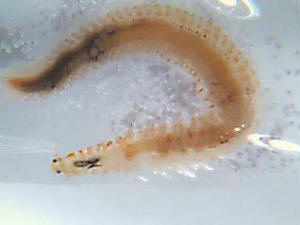 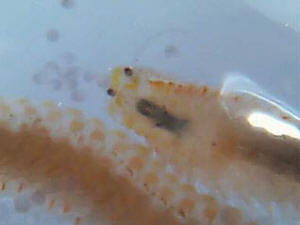
|
Long Clear Thin Worms on Rock... On
top of Spaghetti (Worms) All Covered With Cheese... 11/9/07
Hey guys! <Hi Jane, Mich here.> I have recently added a new piece
of very live rock into my tank about 2 weeks ago. While the moon light
was on last night, I noticed there were 4-5 long(4 inches, and can
stretch) very thin, clear worms of some sort coming out of a hole in my
new piece of rock. They resemble fishing line and can stretch to long
lengths. They are a solid clear color with no obvious head I can see.
Are these harmful to my tank? <Nope!> Should I try to eradicate
them, <Nope!> they are on the bottom of the rock, in a hard to
reach area. <Leave it be. Sounds like a Spaghetti worm (Terebellidae
sp.) to me. They are harmless scavengers feeding on particulate organic
material and detritus. More here:
http://www.reefkeeping.com/issues/2002-06/rs/index.php > Thanks for
your help! <Welcome! Mich>
Jane
|
|

